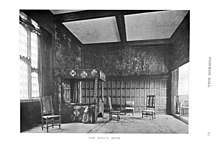Oxburgh Hangings
The Oxburgh Hangings are needlework hangings that are held in Oxburgh Hall, made by Mary, Queen of Scots and Bess of Hardwick.[1][2] The hangings were made between the years 1570 and approximately 1585.[2] An accomplished needlewoman, Bess of Hardwick joined Mary at Chatsworth House for extended periods in 1569, 1570, and 1571, during which time they worked together on the hangings.[3] At that time Mary was imprisoned, in the custody of the Earl of Shrewsbury.[2] The hangings' design was devised at her request.[4] The Oxburgh Hangings consist of green velvet hangings, each with a square centerpiece with octagonal panels of emblems of plants and animals surrounding it.[5][6] The hangings have been made into a wall hanging, two bed curtains and a valance, although these were probably not the original arrangement of the needlework, but instead most likely an arrangement sewn together in the late 17th century.[2] There is also a group of 33 embroideries which are the remains of another hanging.[2] The panels in the hangings, of which there are over a hundred, were made in cross stitch on canvas and applied to a green velvet background, and the designs of the panels were mostly based on four continental emblem books which Mary had; the panel designs were copied from wood-cut illustrations by well-known authors such as Claude Paradin, Conrad Gessner, and Pierre Belon.[2][4][6] Some of the panels' emblems include a phoenix (the symbol of Mary's mother Marie of Guise), and a dragon and a unicorn.[5] The panels made by Mary have her monogram, the letters MA superimposed on the Greek letter phi, and the panels made by Bess have the initials ES.[2]

The hangings are now part of the Victoria and Albert Museum, although they are on permanent long-term loan at Oxburgh Hall.[2]
Further reading
- Emblems for a Queen: the Needlework of Mary Queen of Scots, by Michael Bath, published in 2008, ISBN 978-1904982364
- Needlework of Mary Queen of Scots, by Margaret Swain, published in 1973, ISBN 0 442 29962 1
- The Oxburgh Hangings, by Oxburgh Hall (England), National Trust (Great Britain), published in 1989
References
- "The Oxburgh Hangings, panel".
- "The Oxburgh Hangings".
- Digby, Elizabethan Embroidery, p. 58-63
- "Bard Graduate Center: Decorative Arts, Design History, Material Culture - Galleries at the BGC - Main Gallery - Object of the Month - Pair of Gloves with Emblematic Decoration".
- Elizabeth Mazzola (2009). Women's Wealth and Women's Writing in Early Modern England: 'little Legacies' and the Materials of Motherhood. Ashgate Publishing, Ltd. pp. 57–. ISBN 978-0-7546-6663-9.
- Clive Tulley (1 January 1990). The Visitor's Guide to East Anglia. MPC. pp. 121–. ISBN 978-0-86190-356-6.